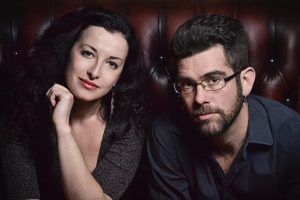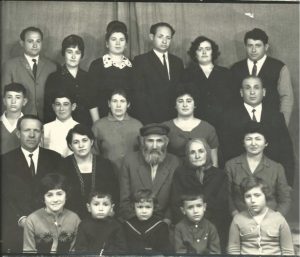“Grandpa Motik dreamed of becoming an artist, and today, I am following his dream.“ Sveta Kundish, cantor and singer, whose family hails from the shtetl Ovruch in Ukraine, has discovered a unique treasure: her grandfather’s tape recordings of the family singing Yiddish songs, reading and telling Russian stories. Sveta’s program “Motik’s Reel-to-Reel“ brings to life a world long gone…

Manuel Miethe
Shtetl memories
“All my life is now based on the roots that go back to the shtetl Ovruch in Ukraine, a small town near the border with Belorussia,” Kundish explains. In the 1990s, following the breakup of the Soviet Union, hundreds of thousands of Jewish families from the former USSR emigrated to Israel, Germany, and North America. Sveta Kundish’s family was part of this great wave relocating from Ukraine to Israel in 1995. Years later her parents discovered a set of reel-to-reel recordings, made by her grandfather Morduk Bezman (1919−1995) in the 1970s and ’80s, which had survived for the past 40 years, and which chronicle the day to day life, songs, and stories of her family – part of a Jewish life there that has all but disappeared. Ovruch dates back over a millennium. A sizable community must have already existed in the early 17th century as a synagogue was built there in 1629. In the late-19th century, six synagogues stood in Ovruch and the Jewish community numbered some 4,000 – over forty percent of the population.
“My great-grandfather Shimon Hershmann [1897–1970] was a Jewish cantor and shochet and very well known for his excellent voice,” Kundish explains. “After the October Revolution in 1917, the Jews were given equal rights, but Jewish customs and religion were now forbidden.” The town’s interwar Jewish community of 3,500 was suppressed by the Soviets who had occupied Ukraine in 1921. “That is why my great-grandfather Shimon could no longer officiate as a chazzan. My grandmother Pessia Hershmann, his daughter, was born in 1922. She had inherited a great musical talent from her father. “Motik, as he was called in the family, was musically very gifted and wanted to become a singer. Because of the difficult circumstances, he could not fulfill his dream, but always sung a lot and gladly. On June 21, 1941, he married my grandmother Pessia. The next day, the German Wehrmacht invaded the Soviet Union, and my grandfather was immediately drafted and sent to the front. After five long and difficult years, my grandfather returned to his hometown, Ovruch.” The vast majority of the town’s Jews had fled to the interior of Russia or were mobilized; today, the mass grave where the eighty-six Jews who remained in Ovruch were murdered upon the German army’s arrival in August of 1941 is situated close to the site of the ghetto where 1,500 Jews from surrounding places were crammed until their murder.
At the end of the 1970s, Motik Bezman bought a tape recorder. And here begins the story of a unique audio recording his granddaughter owns. “My Grandpa recorded the whole family. There are more than two hours of recording, where the whole family sings in Yiddish and Russian, reads and tells stories. The song ‘Tsvey Shvester’, ‘Two Sisters,’ impressed me especially, because through this recording I learned that my grandmother was an excellent folk singer. Yiddish folk songs and ballads were her passion, as well as mine today.”

(c) Svetlana Kundish
A narrated concert
Using these recordings as inspiration, Kundish has collaborated with composer and accordionist Patrick Farrell to tell the story of her Ukrainian Jewish family, from Kundish’s great-grandfather through her present life in Germany as a performer and cantor herself. She met Farrell at a music festival in 2012. Since then, they have been repeatedly working as a duo. Together, the two wrote the program “Motik’s Reel-to-Reel.” Woven around the story are songs in Yiddish, Hebrew, Russian, Ukrainian, and German, either performed live or brought back from the past through these rediscovered recordings. Family photos from the past 100 years, projected onto a screen next to the performers, give the audience a window into typical Jewish life in Ukraine during the years of the USSR, and into the widespread experience of emigration in the years after.
Fulfilling a dream
“Nobody stayed,” says Kundish. “From time to time our family members travel back to Ovrush to visit the cemetery or to join a class reunion.” An estimated 1,000 Jews emigrated from the town since the fall of the Soviet Union. Today, a small prayer house on Lenin Street serves the about 35 remaining members of the local Jewish community. “My large family, who lives in different countries around the world, is very touched that Motik’s tape recordings sound on stage today,” she adds. “Many relatives whose voices my grandfather recorded are no longer alive, and my parents cry and laugh every time they watch the video of our performance in which their beloved ones are heard. According to my mom, my grandparents literally join Patrick Farrell and me as artists on stage. Grandpa Motik dreamed to become an artist, and today, I follow his dream.”
